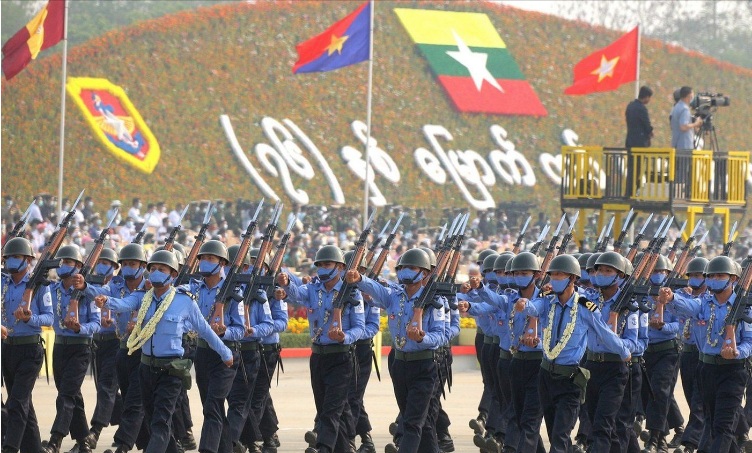By Adam Simpson
As opposition forces continue to rack up battlefield victories over Myanmar’s military, questions over who outside of the war-torn state is helping to fuel the crisis are being asked.
China is easily the most influential international actor in Myanmar but, as with the complexity and diversity of the various insurgent groups in the country, its role is complex.
Less opaque is Russia, which has clearly sided with the junta in its attempt to crush the opposition and is happy to sell it the military hardware to do the job.
Other international actors tend to have little sway with either the junta or opposition forces and have little impact on the ground.
While China has traditionally played puppet master in northern Myanmar, there are signs the opposition victories are causing consternation, and not a little confusion, in Chinese government circles.
China likes it both ways
Beijing has supported various opposition groups for decades but generally values stability over conflict since it has important strategic investments in Myanmar in gas and oil pipelines and factories.
It had a good working relationship with the previous NLD-led government of Aung San Suu Kyi but, since the 2021 coup, has often worked with the military junta that grabbed power to protect its assets.
Nevertheless, China still plays both sides of the field.
Traditionally, it has supported ethnic armed groups such as the Myanmar National Democratic Alliance Army (MNDAA), part of the Three Brotherhood Alliance, and the United Wa State Army, which has a 30,000-strong military and runs two autonomous border regions with China in Shan State. Both forces are successor organisations to the Communist Party of Burma, with Chinese ethnic roots.
China tacitly encouraged Operation 1027, the offensive launched by the Three Brotherhood Alliance in October 2023, to provide a balance of power and competing interests in northern Shan State however it became concerned after a string of impressive victories against the junta.
This reached its peak when the MNDAA took over the strategic town of Lashio in Shan State in July this year.
By mid-August, the Chinese Foreign Minister had flown to Naypyitaw, Myanmar’s capital, for meetings with the junta leader, Min Aung Hlaing, followed by the delivery of six Chinese warplanes, which could be used for airstrikes.
Evidence has also emerged of a Chinese Special Envoy berating United Wa State Army representatives, telling them to rein in the MNDAA.
To put pressure on the opposition groups fighting the junta, China has closed opposition-held border crossings in Shan and Kachin States and severely restricted exports, leading to shortages in food, medicine, and consumer goods.
By late October, relations between China and the junta seemed to have warmed further, with the Chinese ambassador and his military attache meeting with the junta’s Number two, Soe Win, and other high-ranking officials.
However, there are risks for China’s assets in becoming too closely aligned with the junta’s objectives. If ethnic armed organisations feel they have been abandoned, they will transition to prioritising the porous Thai border for arms and supplies.
Anti-China sentiment is also rising in Myanmar, with a bomb detonated at China’s Consulate in Mandalay.
Russia’s marriage of convenience
Since Myanmar’s 2021 coup and the Russian invasion of Ukraine resulted in both countries becoming isolated, Putin and the junta have established a marriage of convenience, mostly over increased trade in military hardware.
Since 2021 Russian entities were the source of at least $US406 million of arms and military related-equipment for the junta.
Russian-made Mi-35 helicopters, MiG-29 jets and Yak-130 light aircraft have been used to conduct air strikes on schools, medical facilities and homes.
A group of Russian Navy vessels from its Pacific Fleet also recently arrived in Myanmar to join the ‘second Myanmar-Russia joint maritime security exercise’.
These increased links have resulted in Myanmar’s desire to join the BRICs. However, even if Russia approved such a decision, it’s likely China would view an application unfavourably.
Other players
Other international actors appear to have little influence on the major players in Myanmar’s civil conflict.
ASEAN, of which Myanmar is a member, is divided over how to deal with the military junta. Although often toothless, ASEAN has demonstrated some unusual grit in its refusal to allow Myanmar’s junta representatives to its leadership meetings.
Its ‘Five Point Consensus’ has achieved little but is rhetorically deployed by the EU and US as the path to peace in the absence of more fulsome engagement.
It’s clear that the solution to Myanmar’s conflict will ultimately be decided by the actors within that country. However, other states have the chance to influence the direction of the conflict.
If Western countries have any interest in Myanmar’s democratic future, then they could do worse than providing a whole lot more diplomatic and material support for the democratic opponents of Myanmar’s brutal military junta.
Dr Adam Simpson is a Senior Lecturer in International Studies at the University of South Australia. His research analyses democratisation, military coups, genocide and civil conflict with a particular focus on Myanmar and Thailand.
Originally published under Creative Commons by 360info™.















